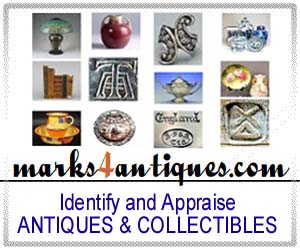UNRAVELING THE MYSTERY OF SILVER HALLMARKS:
Your Guide to Identifying Makers' Marks and Symbols

Welcome to our guide on the different types of makers' marks and hallmarks on silver! Silver marks are groups of symbols found on silver items that help identify its authenticity, purity, and origin. The number of symbols on a silver item can range from two to as many as six.
Silver Marks and Hallmarks in Western Europe
Silver was heavily regulated throughout history and until recently due to its status as a precious metal. Many countries viewed silver as part of their national treasure or federal reserve and closely monitored its value and quantities within their borders. Countries that were notorious for requiring precious metals to have specific markings include Great Britain, France, Germany, and most Scandinavian countries. As a result, antique silver items have many marks, most of which are Duty or Tax marks, with only one or two indicating the silversmith or company that made them. Most countries stopped regulating silver in 2003.

Apart from the duty marks, there are other marks on silver items. For example, there are assay hallmarks, which indicate the silver content, and town or city symbols, which indicate the location of the silver item's manufacture. In smaller towns without an authorized assayer, the Deacon or Head of the local Parish would attest to the silver item's purity and ensure that the proper taxes or levies were paid. As the purity and content standards changed over time, silver hallmarks kept multiplying in number, resulting in thousands of country and city marks to sift through to identify old silver items from those countries.
Another mark found on silver items is the date cipher, especially on antique silver and collectibles from the UK, which indicates the year the silver item was made or assayed. These date ciphers usually run from A to Z and differ from city to city, making them essential in dating and determining the origin of items made of silver and other precious metals.
Antique Silver Marks and Hallmarks from Central Europe
Identifying antique silver items from Central European countries, which are collectively referred to as Bohemia, can be a challenging task. Due to the constantly changing borders of these countries, each new ruler had to reevaluate their national treasure and conduct large-scale inventories to count and weigh all available silver within the newly defined borders. This resulted in the addition of yet another symbol to antique silver items from these countries, signifying that the item was included in the latest count. As the borders continued to change, each new inventory drive resulted in the addition of more hallmarks, which may seem excessive but can provide valuable clues about the age of a given antique silver item or piece of jewelry if properly identified.
American Silver Marks and Hallmarks
In America, silversmiths were not legally required to include Assayer's marks on their silver items. Instead, most American silver and jewelry are signed with logos, initials, and names of the silversmith, workshop, or factory. These markings are known as maker's marks and are typically punched or incised at the bottom or lower down on the side of a piece, commonly referred to as "touchmarks."

There is a notable exception to this, which occurred during the early years of silverware production in America. At that time, most imported silver items came from Europe, particularly Great Britain. In an attempt to imitate English hallmarks, American silversmiths and retailers began adding an array of two to four different symbols that resembled those used in Britain. These are known as "pseudo-marks" and, although they are variations of original English silver hallmarks, many have been officially registered or at least documented and are genuine maker's marks. Most of these pseudo-marks are found on American silver and jewelry dating from the 1840s to the 1920s.
While there is no formal requirement for American silversmiths to include Assayer's marks, maker's marks provide valuable information for identifying the origin and maker of a piece. It is worth noting that American silver items from the 19th and early 20th centuries are highly sought after by collectors, making it crucial to understand the various maker's marks used during that time.
Mexican Silver Marks and Hallmarks
The history of Mexican silver hallmarks dates back to the 1860s, making them a valuable resource for determining the age and origin of antique Mexican silver. However, until the 1940s, most Mexican silver collectibles, including jewelry, hollowware, and decorative pieces, were only marked with the words "Sterling" or "Silver." Standards and symbols varied widely and were inconsistently adhered to by silversmiths, making it difficult to authenticate and date these items.

Despite the challenges, there are a few consecutive periods of a few decades when certain hallmarks were applied more precisely, providing crucial clues for identifying the maker or age of a piece. For instance, the Mexican Eagle hallmark, in slight variations, was primarily used from the late 1940s to the 1970s. Later, in the 1980s and onward, silversmiths in Mexico began using initials and numbers on their silver items that did not necessarily correspond to those of the maker. Instead, this system was based on haphazardly kept regional lists (e.g., Taxco), which fortunately, still offer sufficient clues for identifying the maker or age of a piece.
It is worth noting that most new or older silver items and jewelry made in Mexico contain at least 925 silver content, indicating a high level of purity. This makes Mexican silver items highly sought after by collectors and investors worldwide, as they offer both beauty and value.
Silver marks and hallmarks of China, Hong Kong, and Japan
Today, there is a resurgence of antique silver production in China, primarily in the form of mass-produced silver jewelry, which is gaining popularity across the mainland. This trend is reviving the art of silver-making in China and showcases the skill and talent of its contemporary artisans.
In Japan, a similar belief existed that silver was reserved for the gods, which resulted in minimal antique silver production until the 1960s. Today, Japanese silver production is thriving, and it boasts a unique and modern aesthetic that reflects the country's rich cultural heritage.
Use of Numbers on Antique and Collectible Silver
The numerical silver marks observed next to or near silver hallmarks or makers' marks are essential in determining the actual silver content of a piece of silverware. While different countries may have used their own unique measuring systems in the past, the majority of silver marks today are represented in Thousands. Understanding these markings is essential for assessing the value, age, and origin of a silver piece, making it a valuable skill for collectors and investors alike.
Some countries, especially during the 16th through the 19th centuries, used their own Measures & Weights units system, for example, Germany and some nearby countries used the Lothige or Loth and Russia used the Zolotnik. However, the vast majority of numerical silver marks are represented in Thousands, for example, 925 for .925 or 92.5% sterling silver content.
Knowing the silver content in a piece is not only important for assessing its value but also for identifying its age and origin.
Conclusion
In conclusion, silver marks and hallmarks provide valuable information about the history and authenticity of silver antiques and collectibles. These symbols were used for taxation and regulation purposes, as well as to identify the purity and origin of the silver. While some countries required a multitude of marks, others relied on the silversmith's mark alone.
Therefore, taking the time to research and understand silver markings on antique or collectible silverware is a worthwhile investment. The purity of the silver content can significantly impact the value of the piece. Additionally, understanding the different types of marks or hallmarks on silver and their significance can help collectors and enthusiasts identify and date their treasures. Knowledge of the historical context of these symbols can provide valuable insights into its origin and provenance.
However, it is also important to keep in mind that not all silver items were marked, especially in certain regions of the world, and some marks can be difficult to decipher or authenticate. In any case, the beauty and craftsmanship of antique silver items speak for themselves, and their value extends beyond the symbols and hallmarks that adorn them.
Unlock the true value
of your collection with our comprehensive research guides from identifying makers' marks to appraising all kinds of
antiques and collectibles.
Our up-to-date information will give you an accurate understanding of your items' worth. Don't miss out on this
valuable resource - visit our research tools today!
Search our price guide for your
own treasures





